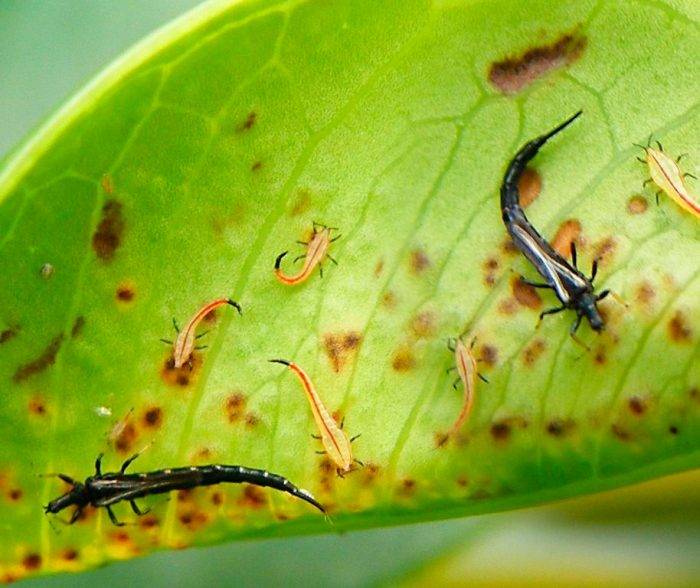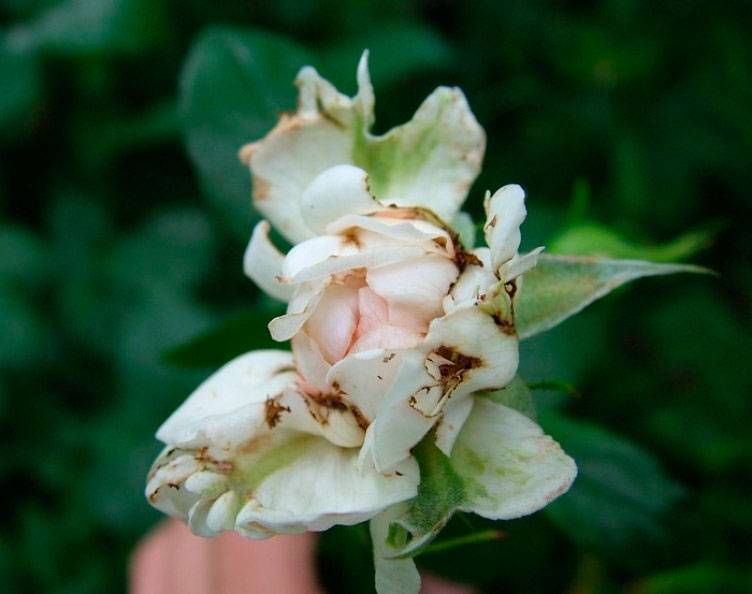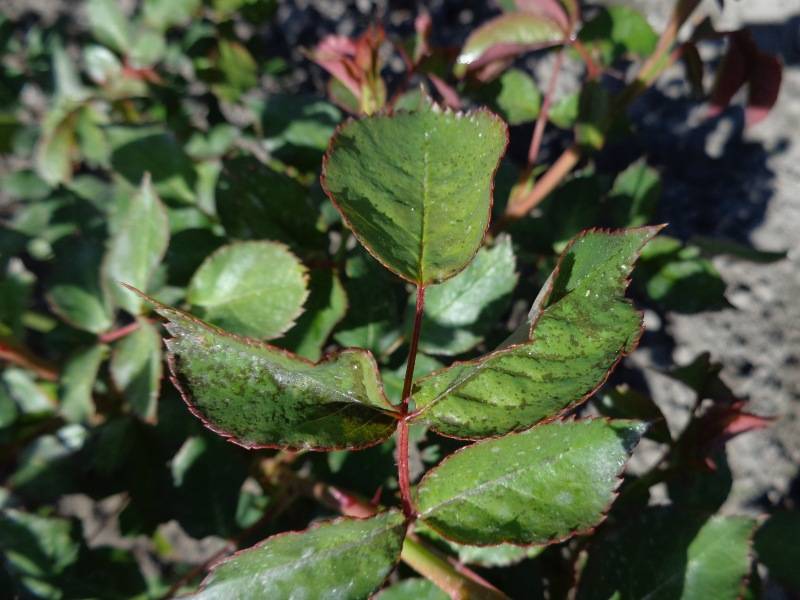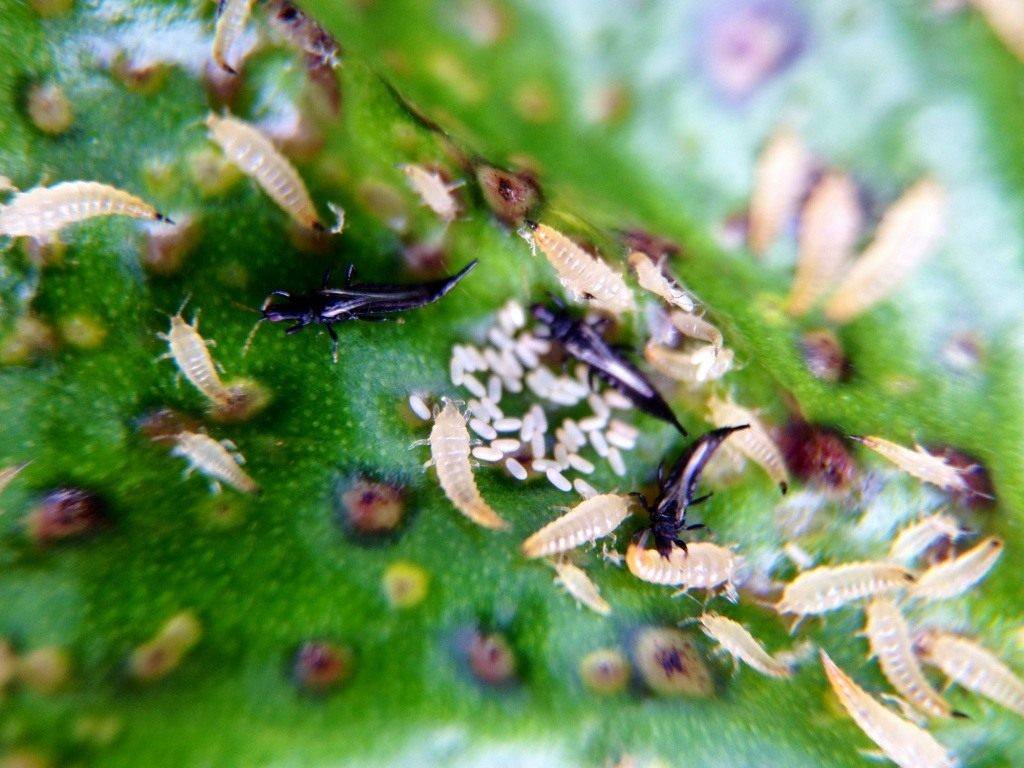Thrips on roses - how to get rid of parasites
Content:
Herbivorous thrips are one of the most harmful insects that feed on vegetables and ornamental crops grown in summer cottages. It is extremely difficult to exterminate this attack, due to their physiological characteristics. To minimize the risks of damage to rose bushes, preventive irrigation should be carried out regularly, taking into account the specifics of the vital activity and development of insects.
Thrips on roses: a general description of pests
Thrips are miniature insects belonging to the order Bubblepods and are found almost everywhere. The length of their body can vary from 0.5 cm to 1.4 cm. The legs are strong and slender, possessing unique suction elements. The oral apparatus is well developed; insects easily pierce plant tissues and absorb cell sap.
Fighting insects is extremely difficult due to the following features:
- at the first stage of their development, it makes no sense to fight them, this is due to the fact that the eggs were laid under the skin of the leaf plates;
- at the last stage of development, thrips are also inaccessible, since they sink deep into the soil layers to lay larvae.
Causes of pests
In winter, the larvae live in heaps of dry leaves or in the upper layers of the soil. In the spring, they come to the surface in search of young juicy greenery. At this time, active growth of weeds is observed, which attract larvae. When the leaves of the grass become tough, the thrips move to roses. First of all, they affect their green part, and only later flowers and buds.
Before developing pest control measures, it is recommended to identify the causes of their occurrence. Among them:
- planting already infected plants. It is not possible to identify them when buying flowers, since thrips can be inside the leaf plates;
- insects affected neighboring flower beds. If it becomes known that these pests have appeared in neighboring areas, it is necessary to take preventive measures as soon as possible.
Signs of defeat
Thrips live in rosebuds, flowers and leaf plates, so it is extremely difficult to notice them. Most often, gardeners do not find the insects themselves, but the results of their life.
In the affected plants, the presence of underdeveloped seeds, the growth of irregular buds, and the appearance of white or yellow spots are noted. If the attack of pests occurred during the flowering period, changes in the edges of the petals, as well as their darkening, will be noticeable. Infected kidneys stop growing and develop abnormally.
Thrips control methods
In the question of how to get rid of thrips on roses, the most effective solution would be to use chemicals. The following drugs have proven themselves well in getting rid of these pests:
- agravertine.The tool has a contact-intestinal effect and is aimed at combating sucking pests. To prepare a working solution, you will need 10 mg per 1 liter of water;
- vertimek. Strong insecticide with contact and intestinal action. The preparation of a solution with a volume of 20 liters will require only 2.5 g of the substance;
- aktara. Highly effective preparation of contact-intestinal action. Differs in rapid penetration into plant tissues;
- decis. The drug has a wide range of applications. Its action is directed against sucking and gnawing insects, as well as their larvae;
- inta-vir. The product is intended to remove insect pests from vegetable and horticultural crops. At the same time, it is not dangerous for beneficial insects and humans;
- karbofos. Medium toxic pesticide effective in pest control in vegetables, horticultural and fruit crops. To prepare a working solution, you will need 7.5 mg per 1 liter of water;
- fufanon. The drug is a wide range of applications. It has fumigant, contact and intestinal effects.
How to get rid of thrips using folk methods
You can also get rid of thrips on roses using folk methods. They are not as effective as chemical preparations, but they are completely safe for humans, birds and beneficial insects.
Most popular recipes:
- dilute 1 teaspoon of chopped garlic or onion in 250 ml of water and let it brew for a day. The finished product is filtered and can be used for work;
- dried marigold flowers are half filled into a 0.5 liter container and filled with water. The bank is placed in a dark place for two days. The finished infusion is filtered and used for processing;
- for 1 liter of water, 100 g of dried flowers of pharmacy chamomile are taken, then everything is mixed and left for 12 hours. After this time, the infusion is filtered, 5 g of liquid or grated soap is introduced;
- 40 g of chopped tomato tops are added to 250 ml of water. After 3-4 hours of infusion, the solution will be ready for use.
Rose Treatment Calendar
To prevent the appearance of these pests, it is recommended to do routine preventive treatments. Depending on the season, they are divided into three groups:
- spring;
- summer;
- autumn.
Spring
With the onset of spring, the invasion of pests and the development of diseases can be prevented as follows:
- spraying with 3% copper and 1% iron sulfate will prevent infection with fungal diseases;
- in the presence of black spot, spraying with sistan is additionally carried out;
- in the second half of April, prophylactic treatment against insect pests, including herbivorous thrips, is carried out;
- in addition to pests, roses are sprayed using infusion of tobacco or dry pepper;
- at the end of spring, the garden and flower garden can be treated with phytoverm, acarin and other preparations.
Summer
In dry weather, it is recommended to irrigate the flower garden with water. This procedure is safe for roses, but at the same time it will help wash off the pests that have settled on them. If thrips are found, they can be removed only with the use of strong insecticides.
Autumn
Autumn is the easiest period to get rid of pests and heal diseases. In most cases, the symptoms by this time are sharply reduced, and the gardener's actions are directed primarily at preparing the roses for winter.
The first autumn treatment is done at the end of flowering. At this time, you can use a solution prepared from 10 liters of water and 1.5 kg of wood ash.After mixing these two components, it is put on low heat, brought to a boil and cooked for 30-40 minutes. Infusion lasts until it cools completely, after which it is filtered and 2 tbsp is added. tablespoons of turpentine, the same amount of table salt, 200 ml of water and liquid soap. The finished composition is used for spraying the bushes.
The second autumn treatment is carried out at the end of the preparation for winter. It involves spraying with a weak solution of ferrous sulfate, and 3-4 days after it with a 1% solution of Bordeaux liquid.
Prevention of spread
Conducting comprehensive preventive measures will prevent a lot of questions about how to remove thrips from the rose garden and from the garden in general. These activities include:
- autumn harvesting of fallen leaves, weeds, followed by their burning;
- removal of dry, damaged and diseased branches at the end of each season;
- soil treatment with insecticides, aimed at getting rid of sucking and gnawing insects;
- avoiding infected branches and leaves as a winter shelter for roses;
- spring cleaning of mulch and thorough loosening of the bush territory. This event will make it possible to neutralize the larvae wintering in the upper layers of the soil;
- obligatory spring treatment of roses from sucking insects;
- processing of the lower half of the bushes during their flowering;
- timely removal of weeds and weeding of the soil;
- abundant regular watering and irrigation of the bushes, which will wash off pests on the leaves;
- treatment of plantings with a solution prepared on the basis of laundry soap. Its action is aimed at creating a protective film covering the green part of plants.
It is quite difficult to quickly rid your favorite flower beds of thrips from thrips, so the actions of gardeners should be aimed at timely preventive measures.




















